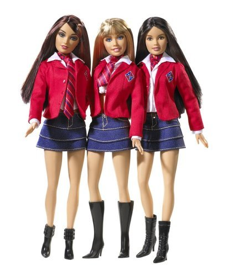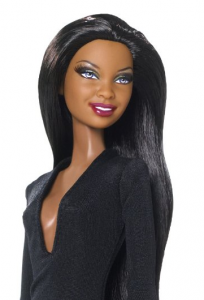
By Whitney, Contributor
(Originally published August 2009)
As a college student, I had spent most of my college career wrestling with the concept of how I have white privilege. Through my studies, I tried to learn about and deconstruct our society’s power structure and my place in it.
Recently, in a Northern California Target of all places, it all came into glaring perspective for me. As I stood in the doll aisle, I saw what Peggy McIntosh had been talking about in her groundbreaking article, “White Privilege: Unpacking the Invisible Backpack “. I scanned the aisle and noticed that the majority of the dolls were white. The portion of the aisle that the “non-white” dolls inhabited seemed like an afterthought, like, “Oh yeah, we have to put out some black and brown dolls, huh? Almost forgot!”.
I stood in the aisle almost paralyzed as I slowly turned around and looked, really looked, at what was on the shelves. The white dolls were overwhelming the majority of products. The colors they were dressed in were all pastels and they were all some kind of princess, professional, or fashionista. As I slowly turned and faced the “brown” doll section, I noticed that this population wore bright and bold colors like red, black, purple, hot pink, and even electric blue. These dolls were more like caricatures with their over plumped red lips, caked on make-up and super short skirts. Instead of being adults, like their white counterparts, these dolls were students in middle or high school. The Latina and Black dolls were very sexily, if not scantily, dressed–the opposite of the white dolls. I’m not sure what school these dolls were supposed go to, but whatever school it was, it allowed super short and tight clothing. Sure fairy princess Barbie may be in a leotard, but for some reason the dolls of color looked like a watered down version of the classic sexual fantasy: the naughty catholic school girl.

The thought popped into my mind that if a little girl of color wants a doll that’s a princess from Target, she’ll have to choose from the white ones. Sure she could buy a doll with her skin color and make her into a princess, but it wouldn’t be the same as seeing one on the shelf already made for her. I know that we could bring in the argument about whether or not a princess is the right thing for any girl to want to be, but just go with me for a second while I try and explain what I saw.
There was an absolute lack of choice in the doll department. I believe that this lack of choice extends into every area of life and is detrimental to the spirit of young girls everywhere, whatever their race.
At a very young age, girls (and boys) begin to ask the question of “why?” Why aren’t there any dolls that are like me, that like to swim and ride bikes? Why aren’t

there more dolls that look like me, with brown hair and skin? Why? Why? Why?…
There are many other, nicer sounding answers, I’m sure. But at this point in my life (I don’t have kids) I want to say very bluntly:
“Sorry kid, it’s called white privilege. And just about everything, everywhere, everyday, is colored by it. That’s why.”
Editor’s Note: The Barbie Basics Collection was released in 2010, after this piece was originally published. One of the Black dolls caused controversy as the plunging neckline on her dress seemed at bit more sexualized than her counterparts in the collection.
Related Content:
The False Mirror: On Diversity, Bizarre Barbies, and Body Image Activism
Barbie’s Plummeting Neckline Causes Uproar
I’m Saving My Cheers Over New “Authentic” Black Barbie Line
Move Over Barbie, Now There’s Something Meatier
Barbie’s Ankles Too Fat for Louboutin’s Stylelist Fashion Blog
A Picture Worth a Thousand Words
Well said Whitney. I find it disturbing that people still refuse to see the significance of issues of representation. The fact that socially normalized images have been commodified and are being sold to our youth is a big deal. The anonymous posting in the coments section is entirely disconnected from reality. When somebody says “it’s just dolls,” or “it’s just business,” they are colluding with a system that promotes racial hierarchy. This is how whiteness, as an idealized standard of superiority, continues to exist unchecked. We tell ourselves it’s just a doll and disconnect it from any social or historical context. It’s not just a doll. As a Chicana feminist scholar/mother these issues are extremely important to me. Thank you for writing this. It needs to be said.
Sure, and you are ok with that?
Things don’t change by accepting the status quo. Look at our political landscape. We all know stores are part of capitalism which is based on supply and demand. If folks don’t have access to a diverse supply then there won’t be any demand for it.
If you went to the store and couldn?t find dolls for your daughters that look like you, would you be swayed by your own argument of capitalism and commercialism?
Sorry. Stores do not promote cultures. They sell things. If a Doll will sell, they’ll make it and stock it.
“There was an absolute lack of choice in the doll department. I believe that this lack of choice extends into every area of life and is detrimental to the spirit of young girls everywhere, whatever their race.”
Your toy department experience has unfortunately been the norm for culturally conscious parents and collectors for far too long. Store shelves overflowing with dolls that promote America’s concept of beauty create a challenging stumbling block for dark-skinned doll seekers.
I have always felt it extremely important for children to see images of themselves in a positive light. Diversity has its place, but a child, particularly a non-white child, needs to understand and realize they are a significant part of this society no matter who attempts to otherwise insinuate.
Has change truly come to America? Most recently, my local Target, Wal-Mart, and Toys R Us have offered a wide variety of wholesome dark-skinned dolls, a welcome change from past experiences. I hope the change spreads like a virus.
Thank you for sharing your observation.
Thanks for the Peggy McIntosh link – I must ‘fess up, I’ve heard the term ‘invisible knapsack’ bandied about but never read the essay. Off to fix that.